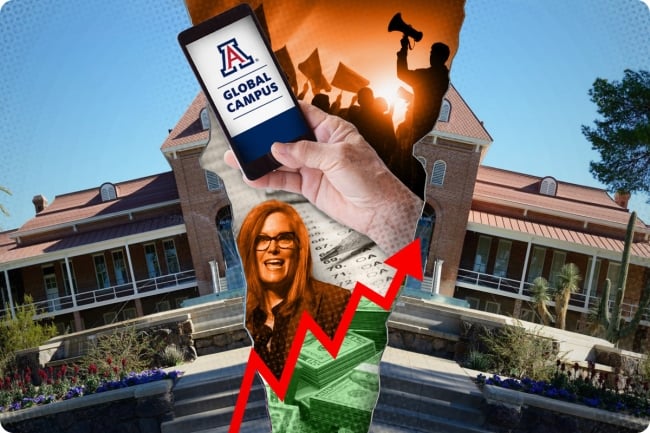You have /5 articles left.
Sign up for a free account or log in.

The University of Arizona is eyeing an integration of its acquired online entity—but rising debt, government oversight and faculty dissatisfaction could stand in the way.
The University of Arizona is looking to completely absorb its acquired online campus, creating another twist in a saga tinged with budget woes and state government concerns.
The University of Arizona Global Campus, formerly known as Ashford University, became a fully operating unit of the University of Arizona in July 2023 after the acquisition about three years before. Online-only UAGC remained a separate entity with its own accreditation and leadership team.
Consolidating UAGC entirely into UA would change that, should the deal go through, but what that may look like—beyond further integrating the UAGC brand and its expertise into UA’s fold—remains to be seen.
More Questions Than Answers
The University of Arizona declined repeated requests for comment, instead pointing Inside Higher Ed to a 13-page letter the university sent Governor Katie Hobbs on Feb. 20.
Hobbs had expressed concerns about the acquisition of Ashford, which she viewed as a failing entity with a bankrupt parent company, Zovio. After the deal, Zovio initially stayed on as an online program manager for the University of Arizona. When the contract between Zovio and UA ended, 791 of the 909 Zovio employees were rehired at UAGC.
“In addition to the financial concerns raised during the process, significant ethical problems with Ashford University’s business model appear to have been brushed aside by university leadership during the acquisition,” Hobbs said in a separate letter sent to UA on Jan. 25.
Exactly when UA began discussing integrating UAGC is unclear and could not be confirmed by the university. According to UA’s letter sent to the governor, the university hired consulting firm Ernst and Young to conduct a 12-week analysis of the potential for a consolidation and expect to review the results by June 30, 2024.
While university officials also declined to provide reasoning behind a push for integration, there’s varied speculation. Some experts said the motivation is gaining access to UAGC’s nearly 24,000 students, while others guessed the goal is getting access to a large technology platform.
Aaron Lacey, chair of the higher education practice at the law firm Thompson Coburn, pointed out it could ease governance practices, as well as regulatory and operational efficiencies in general.
“It’s just inefficient to have two totally separate institutions,” he said. “Also, there’s just the prestige. UA is a big, well-respected, university flagship state entity, and for now folks graduating from UAGC, that’s not who’s granting their diploma.”
The Other Online Program
After UAGC’s acquisition, its former president, Paul Pastorek, in July stepped into a senior vice president role at University of Arizona. He resigned four months later. Gary Packard has been filling the role on an interim basis.
Packard also oversees UA’s lesser-known Arizona Online, which launched in 2015 and has grown to enroll roughly 9,400 students. It has a more traditional approach for online classes, which are taught by University of Arizona professors in semester formats.
In comparison, UAGC serves about 24,000 students, offers courses on a five-week rolling term and has open enrollment.
“We’re built to extend the university’s operations, while UAGC is built to be an online operation,” said Caleb Simmons, executive director of online education.
Simmons, who oversees Arizona Online, said if the integration were to move forward, he would welcome UAGC’s expertise in the online sector.
“I do believe in the possibilities for UAGC; I’m a convert,” he said. “We have a responsibility as a state school, as a land-grant school, to provide education to people who aren’t typically served. I believe UAGC allows us to do that in a way that we cannot without them.”
However, it is unknown what will happen to Arizona Online if UAGC is folded into the mix. Ernst and Young began looking into a “strategic alignment” on Feb. 14, according to UA’s letter to Hobbs. The consulting firm has been reviewing financials, organizational alignment and “potential risks” involved in combining the two.
“From the surface I understand the rationale, which is that Arizona Online is great, it just won’t move the needle fast enough,” said Phil Hill, a market analyst and ed-tech consultant with Phil Hill and Associates. “But quietly, Arizona Online seems to be growing. It’s ironic—it’s not just that they have an online program, but it seems to be doing quite well.”
Future Considerations
That decision, along with the integration as a whole, will take several weeks to come to light, according to the UA letter.
In the interim, the university is facing a $177 million budget shortfall, which caused Fred DuVal, the chair of the state’s Board of Regents, to step down on March 1 after Hobbs blasted the board for having “no coherent vision.” The board’s executive director, John Arnold, also stepped down to focus on his role as interim chief financial officer at UA.
On March 4, the Department of Education also warned the university it would be on the hook for the debt incurred by Ashford University students by way of discharged student loans, from before it was acquired and became UAGC. It is not known how much UA would have to repay, but UA officials have repeatedly stated they are not responsible for the actions of UAGC—then Ashford—before its acquisition.
Some experts say the move is intended to make an example out of the University of Arizona and scare off other institutions from purchasing online giants. The University of Idaho was in the process of acquiring the University of Phoenix in November 2023. However, that deal has been contested to the point that the Idaho Supreme Court has gotten involved, dealing with claims the university violated the state’s open meeting laws by allegedly discussing the Phoenix deal behind closed doors.
“I have little doubt that it is a big motivation with how hard they’re going after [the University of] Arizona,” Hill said. “This is how the [Education Department] works right now; it’s a coordinated regulatory campaign. I would be shocked if I ever found out there was no relationship to what was happening in Idaho.”
The University of Arizona also needs to consider the impact of taking on UAGC’s thousands of students—including their less-than-stellar six-year graduation rates, which sit at 18 percent for students who began during the 2015–16 school year. In 2020—the most updated numbers offered from UAGC—the retention rate was 31 percent.
“This is why states have separate flagships and community colleges,” said Lacey, of Thompson Coburn’s higher education practice. “They have a different mission and are usually succeeding at a different level academically, so it makes sense to keep it separate. This could be the same thing with UAGC—which doesn’t make it bad, but it may have different challenges.”









